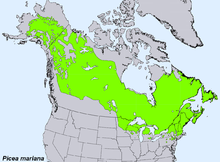Black spruce
| Picea mariana | |
|---|---|
 |
|
| Stand of black spruce near Inuvik, Northwest Territories, Canada | |
| Scientific classification | |
| Kingdom: | Plantae |
| Division: | Pinophyta |
| Class: | Pinopsida |
| Order: | Pinales |
| Family: | Pinaceae |
| Genus: | Picea |
| Species: | P. mariana |
| Binomial name | |
|
Picea mariana (Mill.) Britton, Sterns & Poggenburg |
|
 |
|
| Synonyms | |
|
Synonymy
|
|
Picea mariana (black spruce) is a North American species of spruce tree in the pine family. It is widespread across Canada, found in all 10 provinces and all 3 Arctic territories. Its range extends into northern parts of the United States: in Alaska, the Great Lakes region, and the upper Northeast. It is a frequent part of the biome known as taiga or boreal forest.
Picea mariana is a slow-growing, small upright evergreen coniferous tree (rarely a shrub), having a straight trunk with little taper, a scruffy habit, and a narrow, pointed crown of short, compact, drooping branches with upturned tips. Through much of its range it averages 5–15 m (15–50 ft) tall with a trunk 15–50 cm (6–20 in) diameter at maturity, though occasional specimens can reach 30 m (98 ft) tall and 60 cm (24 in) diameter. The bark is thin, scaly, and grayish brown. The leaves are needle-like, 6–15 mm (1⁄4–9⁄16 in) long, stiff, four-sided, dark bluish green on the upper sides, paler glaucous green below. The cones are the smallest of all of the spruces, 1.5–4 cm (1⁄2–1 1⁄2 in) long and 1–2 cm (1⁄2–3⁄4 in) broad, spindle-shaped to nearly round, dark purple ripening red-brown, produced in dense clusters in the upper crown, opening at maturity but persisting for several years.
...
Wikipedia

